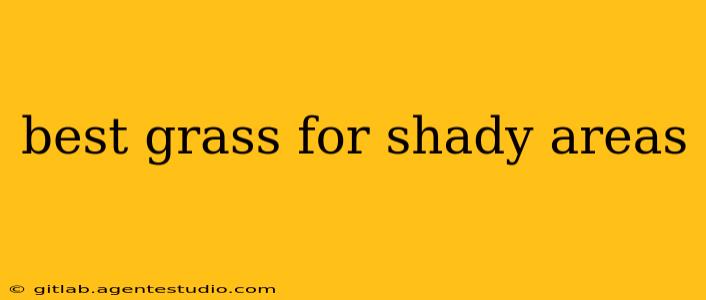Choosing the right grass for your shady lawn can be tricky. Unlike sun-loving grasses that thrive in full sunlight, shade-tolerant varieties require specific characteristics to flourish in low-light conditions. This comprehensive guide will help you select the best grass for your shady areas, ensuring a lush and healthy lawn, even in the deepest recesses of your garden.
Understanding Shade and its Impact on Grass
Before diving into specific grass types, it's crucial to understand the nuances of shade. The amount and type of shade significantly impact grass growth.
-
Light Shade: This typically refers to areas receiving at least four hours of direct sunlight daily. Many grasses can tolerate light shade, though their growth might be slightly slower.
-
Partial Shade: Areas receiving two to four hours of direct sunlight daily fall under this category. You'll need a grass variety specifically bred for partial shade to maintain a healthy lawn.
-
Deep Shade: This signifies less than two hours of direct sunlight daily. Only a few highly shade-tolerant grasses can survive and thrive in these conditions.
Top Choices for Shady Lawns:
The best grass for your shady area will depend on your specific conditions. Here are some top contenders, categorized by shade tolerance:
For Light to Partial Shade:
-
Tall Fescue: A popular choice known for its hardiness, shade tolerance, and ability to withstand wear and tear. Tall fescue is relatively low-maintenance and drought-tolerant once established. It's also a good option for cooler climates.
-
Fine Fescue: This variety excels in shady conditions and requires less fertilization than other grasses. Fine fescue is a low-growing option, perfect for areas where you want a neat and tidy lawn. Multiple types exist, including hard fescue, sheep fescue and creeping red fescue, each with slightly different characteristics.
-
Kentucky Bluegrass: While generally preferring full sun, some cultivars of Kentucky bluegrass can tolerate light to partial shade. It's known for its attractive blue-green color and relatively soft texture.
For Deep Shade:
Finding a grass that thrives in deep shade can be challenging. Often, ground covers or alternative solutions are preferable. However, if you are determined to have grass, consider these options:
-
Hard Fescue (a type of fine fescue): Known for exceptional shade tolerance, hard fescue can survive even in deep shade, though growth might be slower and less dense than in sunnier locations.
-
Shade-tolerant blends: Many seed companies offer grass seed blends specifically formulated for shady conditions. These blends typically combine several shade-tolerant varieties for optimal performance.
Beyond Grass: Alternative Ground Covers for Shady Areas
If maintaining a full lawn in deep shade proves too difficult, consider these alternatives:
-
Creeping Thyme: A fragrant, low-growing ground cover that thrives in dry shade and adds a beautiful texture to the landscape.
-
Sedum (Stonecrop): A succulent ground cover with diverse varieties, offering different textures, colors, and flowering times. Sedum is drought-tolerant and excels in full or partial shade.
-
Ivy: Various ivy varieties can create a lush, ground-covering carpet in deep shade.
Preparing the Soil: Crucial for Success
Regardless of the grass type you choose, proper soil preparation is vital for a healthy lawn in shady areas. Shady areas often suffer from compacted soil and poor drainage. Before planting, amend the soil with compost or other organic matter to improve drainage, aeration, and fertility.
Maintenance Tips for Shady Lawns:
-
Watering: Water deeply and less frequently to encourage deep root growth. Avoid overwatering, which can lead to fungal diseases.
-
Mowing: Mow higher than you would in sunny areas to promote shade tolerance and prevent scalping.
-
Fertilizing: Use a fertilizer specifically formulated for shade-tolerant grasses.
By carefully considering your shade levels and following these guidelines, you can create a beautiful and thriving lawn, even in the shadiest corners of your yard. Remember to consult with a local gardening expert for personalized recommendations based on your specific climate and soil conditions.

